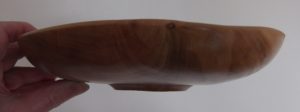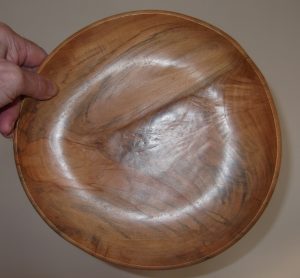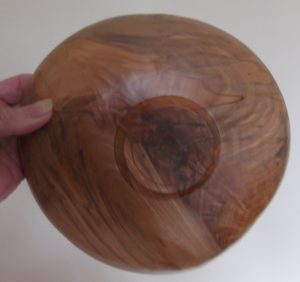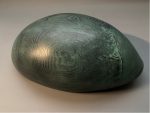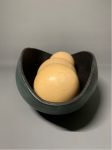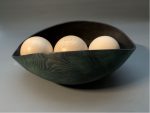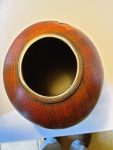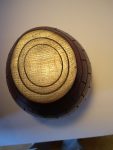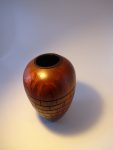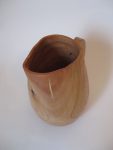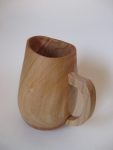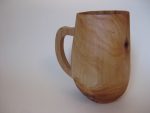Green Wood Warping
Winner of March Competition
Graham Brooks
Comments from David Green of Turners retreat, who judged the competition.
“Graham clearly put a lot of thought into this project, and the results are clear to see. Every step has been carefully considered. I think the fact it finds its own level without a plinth, even though not by design doesn’t distract attention away from the finished pod.”
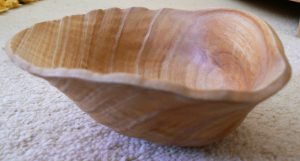
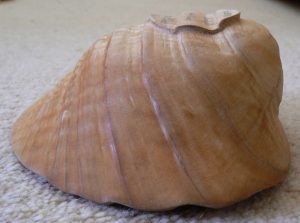
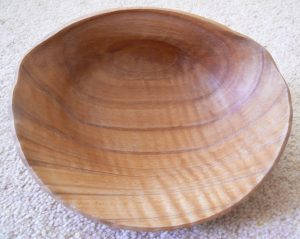
Philip Davis
I offered an acquaintance to convert their Eucalyptus tree stump, into a seat. Some of the wood I wrapped up and took home. Knowing David Appleby and his work I was perhaps inspired to try my hand, at turning wet eucalyptus.
I turned thinly as quickly as possible and completed the bottom in my wood four jaw chuck, I could see that it was already moving. I applied no finish at this stage due to the high moisture content.
In the morning it was, all ready, most of the way to it’s final shape, which was accomplished in about three days. When it was quite dry I sanded with 320 grit as best I could to remove raised grain and applied “Briwax” natural wax polish. Any idea of remounting it for finishing was out of the question.
Not only is the external shape distorted, but the shrinkage of the softer wood between the annual rings also contributed to the final effect. My wife liked the quirky nature of it, so it is part of the semi-permanent in house collection. Another similar sold in our “One Craft Gallery” in Shepton Mallet. Proving perhaps that there is a customer for everything, if they can be found.
Apart from trying to finish the dry convoluted shape, the turning was straightforward. It did cause some astonishment at the next meeting of “Martock and District” woodturners.
This platter started life as a part of a beech tree outside the senior citizens club on Wroxham Road, Sprowston until the wind blew it down in a gale the club is where 11 of us guys decided to start a woodturning club in 2007. The tree surgeon cutting it up said I could have some if I could get it home, so I carried a piece as much as I could carry to where I live ¼ mile away and came back with a sack barrow. I cut the logs down the pith line and 2 or 3 inches thick then wrapped them in plastic to make them spalt.
After 2 or 3 months I sorted out a large branch section and cut it down the middle about 2 inches thick and turned two platters which turned out (forgive pun) to be crotch figured – very good they looked. I wrapped them in newspaper to slow down the drying process. When taken out after drying I found they were warping but I thought someone might like the effect so I put them out for sale in our Blakeney Guild Of Many Crafts sale. After a week or so someone said one of the platters had been taken out and said the reason was it was not of a quality to sell, so I looked for the other platter and could not find it and it just happened someone had bought it. So who was right? The person who took it off sale or the person who bought it?
Graham Brooks
Social media – Facebook Graham Brooks – Instagram grahambrooks64
I have no access to newly felled wood but had a quite wet piece of Ash log which a cousin dropped off before Christmas. It was left out most of the winter, fully exposed to the rain, snow and frost. When the weather was civilised enough for me to venture out with my chainsaw and cut up the log, I decided to cut two pieces for medium and small hat blanks, which I’ve been intending to try turning for some years and one blank for a thin walled bowl for this competition. and a forth blank for a bowl to be twice turned. I had a fall-back position of submitting a hat if the thin walled bowl failed.
I had the thought of trying to get the thin walled bowl to deform to the shape of an opening seed pod. The bowl was about 200mm diameter, 120mm deep and with a 4mm wall thickness when turned. It is now about 290mm long and 150mm wide. The holding Tenon was removed to maintain the wall thickness.
After turning and wet sanding I kept the piece as wet as possible by spraying with water and started to apply pressure across the side grain first with one light Irwin cramp close to the rim and later with two cramps as far down the wall as the jaws of the cramps would allow. The pressure was increased and applied gradually as the bowl distorted. Eventually the piece was moved into the house to dry with the cramps still applied. There was some additional distortion around a bark intrusion.
On completion of the drying I tried various finishes on test pieces and settled on brushing the external surface with a liming brush to expose the grain before applying Chestnuts black spirit stain. When dry, Liberon Verdigris wax was applied and worked into the wood grain before being buffed with a brush and finally with a cotton cloth.
My expectation was that a plinth of some kind would be required to enable the piece to ‘sit’ reasonably level but was pleased to see that it ‘found its own level’ every time even with the three spheres added to represent seeds.
Roger Groom
An Oak vase, approx9″ high and varying between 5 1/2″ and 4 3/4″ at its widest point. It was turned when very wet and turned in one hit. The wall thickness is about 4-5mm. The horizontal lines were turned using a point tool and the vertical lines were cut by hand after marking out with my indexing jig. At this stage it had already started to move. The finish I used on this piece was one I read of in a Woodturning magazine article by a chap called Andy De Pietro. He called it “Oakobolo” it consists of using vinegar and wire wool, which because of its moisture content went very black. It was then sanded quite vigorously to remove the bulk of the stain leaving the grain with the black in it. Then coats of red and yellow Chestnut spirit stains were applied, and allowed to dry thoroughly. Once dry, and by this time the movement within the piece had stopped, three coats of Rusting Danish oil were applied leaving a surface which did look a bit like Cocobolo. The surface due to the shrinking was left very tactile due to the shrinkage with the biggest movement being on the foot.
Peter Jackson
When a friend was taking out a Eucalyptus tree from his garden and offered me some of the wood I could not refuse. Like a lot of woodturners (I think) you can’t have enough wood, whether it be fantastic burr elm, half rotten logs or blanks which you buy on a whim and never get around to using. I decided to try and turn a vase out of some of the wet wood knowing that it might crack and change shape as it dried. However having turned the log with the pith fairly central and managed to get the wall thickness down to around 4mm I was not prepared for and slightly dismayed at the amount of distortion that eventually happened. After a bit of thought and discussion with my wife and seeing the shape of the top of the “vase” I decided to try and turn it into a handled jug and you can see the result in the photos. The approximate size is 205mm high x 125mm x 170mm(inc handle). The piece was turned mostly with my favourite 1/2” bowl gouge externally and hollowed mainly with a Munro hollowing tool, using the scraper tip aswell as the normal circular cutting tip. The handle was made from a piece of recycled oak cladding. The hardest part of all this was probably getting the handle to fit the jug bearing in mind that there was no “uniform” surface on the jug and a lot of wrinkles due to the drying process. It took a lot of sanding and fitting to get it looking reasonable. The handle is attached by glued oak dowels through the wall of the jug. One or two splits in the wood had to be filled before the jug was finished with several coats of Danish Oil inside and out.
The result is a rather quirky looking jug which is likely to get used for displaying dried flowers and the like, maybe even with some eucalyptus foliage!

